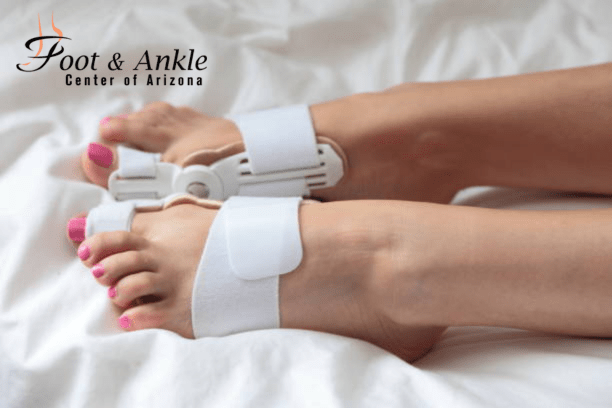
Do your feet hurt near the big toe? You may have a bunion. A bunion is a bony bump that forms at the base of your big toe. It can be painful and make shoes hard to wear. You’re not alone. Many people get bunions. In fact, the American Orthopedic Foot & Ankle Society says over one-third of adults have bunions.
The good news? You don’t always need surgery right away. Many people can feel better with simple care at home. At the Foot and Ankle Center of Arizona, we believe in helping you make the best choices for your foot health. That’s why we’re sharing 5 free bunion repair techniques you should know.
Let’s take a look at each one!
1. Wear Shoes That Fit Well
Tight shoes can make bunions worse. One easy fix? Choose better shoes.
Look for shoes that:
-
Have a wide toe box
-
Don’t pinch your toes
-
Are flat or low-heeled
Soft and roomy shoes take pressure off the bunion. You can even use sneakers with soft sides. This can help reduce pain and stop your bunion from getting bigger.
Dr. Kris A. DiNucci, our foot and ankle doctor, says, “Wearing the right shoes is one of the easiest and best ways to ease bunion pain.”
2. Try Ice Therapy
Is your bunion red or swollen? Put some ice on it!
Ice helps calm the area and bring down swelling. This is a great, free way to feel better fast.
How to do it:
-
Wrap ice in a towel or use a cold pack
-
Place it on your bunion for 10 to 15 minutes
-
Do this 2 to 3 times a day
Never put ice right on your skin. Always wrap it in cloth to stay safe.
3. Do Toe Stretches
Gentle movements can help your toe feel better. Stretching your toes keeps them flexible. It may even slow down the bunion.
Here’s one to try:
-
Sit in a chair and place your foot flat on the floor
-
Lift your big toe while keeping the rest down
-
Hold for 5 seconds, then relax
-
Repeat 10 times
You can do this a few times each day. It helps your toe stay straight and strong.
According to the National Institute on Aging, regular foot exercise can improve comfort and strength.
4. Use Padding or Bunion Splints
Padding can make shoes more comfy. Bunion pads or splints keep the bunion from rubbing.
You can find pads at:
-
Drugstores
-
Online
-
Some grocery stores
They are soft and stick to your skin or shoe. Some people also try toe spacers or splints that gently hold the toe straight at night.
These don’t fix the bunion, but they help ease pain.
5. Watch Your Weight and Activity
Extra weight puts pressure on your feet. Staying at a healthy weight helps your bunion feel better.
Try these tips:
-
Walk or swim for gentle movement
-
Eat healthy meals
-
Rest when your feet hurt
Also, avoid long walks in bad shoes. Give your feet a break when they need it.
A study in Foot & Ankle International found that even 10% weight loss helped ease foot pain.
When Should You See a Doctor?
Free bunion repair techniques can help, but sometimes you need more care.
See a foot doctor if:
-
The pain won’t go away
-
Your toe is bending more
-
Walking becomes hard
-
You can’t wear shoes
At the Foot and Ankle Center of Arizona, we help people with bunions every day. Dr. Kris A. DiNucci is a trusted foot and ankle surgeon. He listens, answers your questions, and gives you the right care.
FAQs
Can bunions go away on their own?
No, bunions don’t go away by themselves. But using good shoes and stretches can help with pain.
Are bunion splints safe for kids?
Yes, some splints are made for kids. Ask a doctor first to be sure it’s the right fit.
When do I need surgery for a bunion?
Surgery may be needed if pain keeps you from walking or doing daily things. Your doctor will help you decide.
Final Thoughts
Bunions can hurt, but help is here. Many people feel better with simple and free bunion repair techniques. Wearing good shoes, icing the area, stretching, using pads, and staying active all make a big difference.
But remember: if pain gets worse or won’t go away, it’s time to see a doctor.
At the Foot and Ankle Center of Arizona, we’re here for you. Dr. Kris A. DiNucci, our expert podiatric foot and ankle surgeon, will help you find the best care—surgical or not.
Want to learn more? Need a check-up? Contact us today through the Contact Us or Request an Appointment pages on our website. We’re located in Scottsdale, AZ, and we’re ready to help your feet feel better!